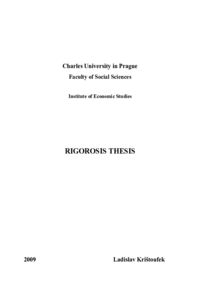Fractality of stock markets: a comparative study
Fraktalita akciových trhů: komparativní studie
rigorózní práce (UZNÁNO)

Trvalý odkaz
http://hdl.handle.net/20.500.11956/87688Identifikátory
SIS: 79875
Kolekce
- Kvalifikační práce [17642]
Autor
Vedoucí práce
Fakulta / součást
Fakulta sociálních věd
Obor
Ekonomie
Katedra / ústav / klinika
Institut ekonomických studií
Datum obhajoby
23. 10. 2009
Nakladatel
Univerzita Karlova, Fakulta sociálních vědJazyk
Angličtina
Známka
Uznáno
Tato práce se zaměřuje na prezentaci nové metody pro popis fraktality finančních časových řad. Popisujeme nejvíce používané techniky pro určení Hurstova exponentu - R/S, M-R/S a DFA. Dále prezentujeme vlastní simulace pro dané metody, které nebyly dříve uvedeny v literatuře. Výsledky jsou pak použity v nové metodě časově závislého Hurstova exponentu s konfidenčními intervaly. Navíc poukazujeme na výhody použití všech třech postupů najednou pro důsledné rozlišení mezi nezávislými procesy, procesy s trendy, procesy s krátkou pamětí a procesy s dlouhou pamětí. Nakonec aplikujeme navrženou metodu na 13 různých světových akciových indexů a přicházíme k zajímavým výsledkům. Podle autorova nejlepšího vědomí práce prezentuje zatím nejširší aplikaci časově závislého Hurstova exponentu na akciové indexy.
The main focus of the thesis is the introduction of new method for interpretation of fractality aspects of financial time series together with its application. We begin with description of various techniques of estimation of Hurst exponent - rescaled range, modified rescaled range and detrended fluctuation analysis. Further on, we present original theoretical results based on simulations of three mentioned procedures which have not been presented in literature yet. The results are then used in the new method of time-dependent Hurst exponent with confidence intervals developed in this thesis. Moreover, we show important advantage of using the mentioned techniques together to clearly distinguish between independent, trending, short-term dependent and long-term dependent properties of the time series. We eventually apply the proposed procedure on 13 different world stock indices and come to interesting results. To the author's best knowledge, the thesis presents the broadest application of timedependent Hurst exponent on stock indices yet.
